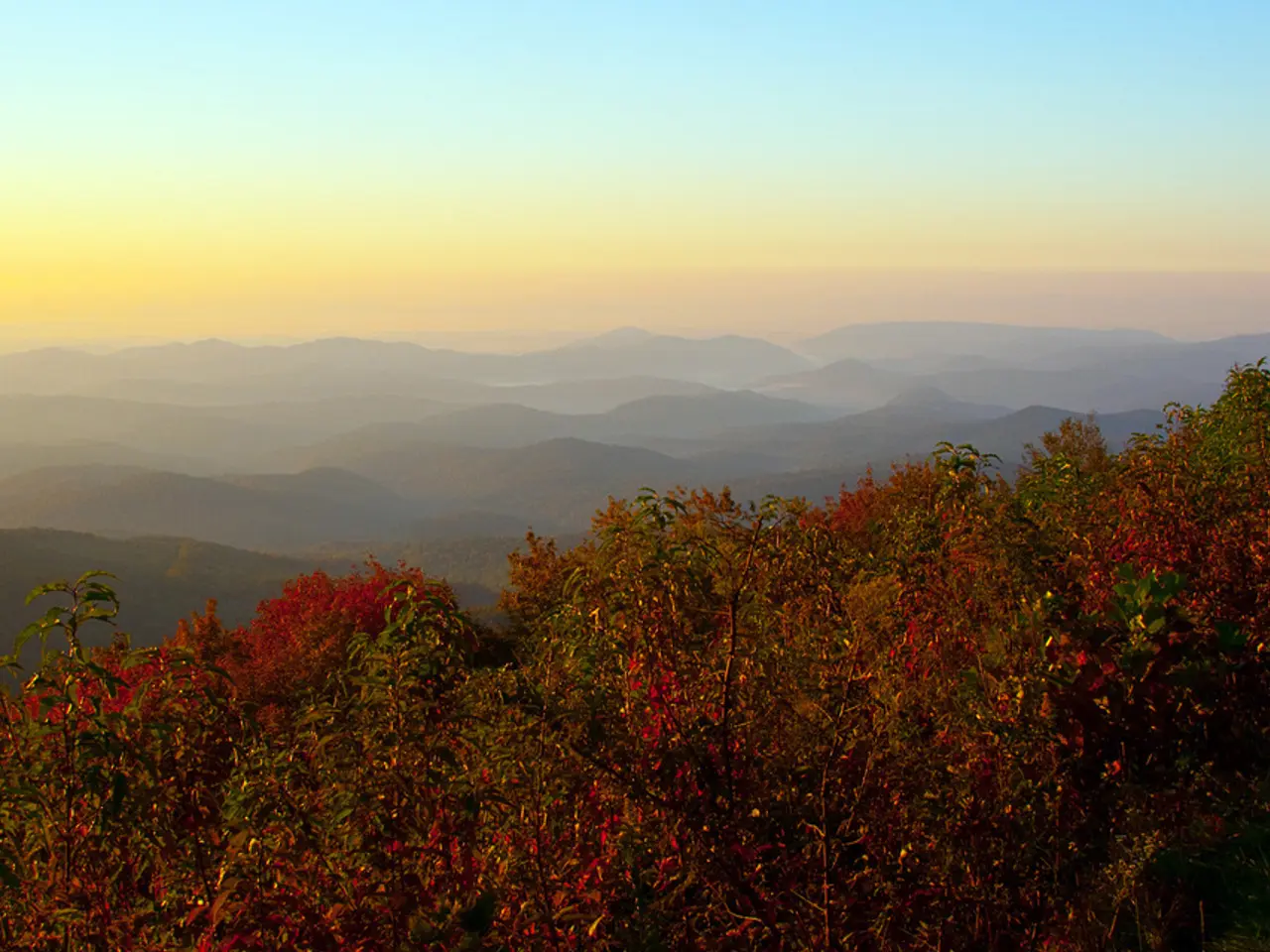Explore the Scenic Wonders of Shenandoah National Park
Shenandoah National Park, nestled in the picturesque state of Virginia, is a nature lover's paradise offering breathtaking landscapes, diverse wildlife, and endless opportunities for adventure. However, it's important to note that this pristine wilderness does not provide public transportation or taxi services within its boundaries[1][2].
The primary way to navigate the park is by private vehicle along Skyline Drive, the park's only public thoroughfare stretching 105 miles from north to south[1][2]. This scenic road offers access to ranger stations, campgrounds, lodging, and trailheads. Parking is available at various points along Skyline Drive, but spaces can fill up during peak times[2].
For those seeking a more leisurely exploration, Skyland Stables offers guided trail rides from May through October[4].
The mountains in Shenandoah National Park are usually 10 degrees cooler than the valley below and can experience severe winters with snow and ice, as well as summer showers. Visitors are advised to dress appropriately for the weather and terrain[5].
Established by Congress in 1926 and fully established in 1935, Shenandoah National Park spans over 196,000 acres, with more than 500 miles of hiking trails, including a 101-mile segment of the Appalachian Trail[6]. The park is home to more than 150 miles of horse trails and seven picnic areas with facilities[7].
Three visitor centers—Dickey Ridge Visitor Center, Harry F. Byrd, Sr. Visitor Center, and Loft Mountain Information Center—provide information and resources for visitors[8]. The Headquarters office is located near Thornton Gap and Luray, Virginia[9].
The park's campstores, located at Elkwallow, Big Meadows, and Loft Mountain, offer supplies and amenities for campers[10]. Lodging options within the park include Big Meadows Lodge, Lewis Mountain Cabins, and Skyland Lodge[11].
It's essential to remember that pets are allowed in campgrounds but not in lodging units and must be on a leash at all times in the park[3]. Only a few trails in the park are not open to pets, totaling fewer than 20 miles of the 500 miles of trails[3].
Ticks, which can carry Lyme disease, are prevalent in the park, so it's crucial to check yourself thoroughly after hikes and use tick repellent[12].
The park is easily accessible by I-66 and Highway 340 South to the north entrance at Front Royal, Highway 211 for the central entrance at Thornton Gap, Highway 33 at Swift Run Gap, and I-64 at the Rockfish Gap entrance[13]. Shenandoah National Park is approximately 75 miles west of Washington, D.C.[14].
Visitors should be aware that the park is transitioning to a fully cashless payment system for entrance and campground fees[3]. Capacity fees for campstores range from $25 for 1-6 passengers to $200 for 26+ passengers[15].
In summary, a private vehicle is the best way to explore Shenandoah National Park, with Skyline Drive being the main and only road through the park. Visitors can also enjoy guided trail rides, hiking, picnicking, camping, and visiting the park's various facilities and visitor centers. By following some simple guidelines, such as checking for ticks after hikes and keeping pets on a leash, visitors can ensure a safe and enjoyable experience in this beautiful wilderness.
- Shenandoah National Park, a nature lover's haven in Virginia, showcases breathtaking landscapes, diverse wildlife, and endless opportunities for adventure.
- Navigate the park primarily via private vehicle along Skyline Drive, the park's only public thoroughfare spanning 105 miles.
- Skyline Drive offers access to ranger stations, campgrounds, lodging, and trailheads, with parking available at various points.
- For those seeking a leisurely exploration, Skyland Stables offers guided trail rides from May through October.
- The mountains in Shenandoah National Park are usually 10 degrees cooler than the valley below and can experience severe winters with snow and ice, as well as summer showers.
- Visitors are advised to dress appropriately for the weather and terrain to ensure a comfortable experience.
- Established in 1926 and fully established in 1935, Shenandoah National Park spans over 196,000 acres and features more than 500 miles of hiking trails.
- The park is home to over 150 miles of horse trails and seven picnic areas with facilities.
- Three visitor centers—Dickey Ridge Visitor Center, Harry F. Byrd, Sr. Visitor Center, and Loft Mountain Information Center—provide information and resources for visitors.
- The Headquarters office is located near Thornton Gap and Luray, Virginia.
- The park's campstores, located at Elkwallow, Big Meadows, and Loft Mountain, offer supplies and amenities for campers.
- Lodging options within the park include Big Meadows Lodge, Lewis Mountain Cabins, and Skyland Lodge.
- Pets are allowed in campgrounds but not in lodging units and must be on a leash at all times in the park.
- Only a few trails in the park are not open to pets, totaling fewer than 20 miles of the 500 miles of trails.
- Ticks, which can carry Lyme disease, are prevalent in the park, so it's crucial to check yourself thoroughly after hikes and use tick repellent.
- Shenandoah National Park is easily accessible by I-66 and Highway 340 South to the north entrance at Front Royal, Highway 211 for the central entrance at Thornton Gap, Highway 33 at Swift Run Gap, and I-64 at the Rockfish Gap entrance.





